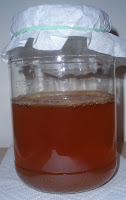
My first DIY SCOBY experiment has now come to an endend! Although from the side it looked like two cultures had actually grown, it was just one. Because the top layer was younger than the bottom layer, the top layer had a lighter, cream color, compared to the darker brown color of the bottom layer. The edges (but not the center) of the SCOBY separated a bit. However, the two layers were pretty cemented together, and they seemed all cozy and comfortable right next to each other, so I guess together as one they were meant to be.
The kombucha tea itself was definitely way over-fermented! It tasted like kombucha tea all right, but it was so acidic that you would not want to drink more than sip (taste-wise and health-wise!) The pH of the tea was around 1-2. I used some as strong starter tea, and I also mixed some regular kombucha tea with the over-fermented KT (so the pH wasn't as low), so I could store some extra SCOBYs that I want to give away in the fridge.
















































 It's beginning to smell like apple cider vinegar/kombucha, which is a good sign! :)
It's beginning to smell like apple cider vinegar/kombucha, which is a good sign! :)
